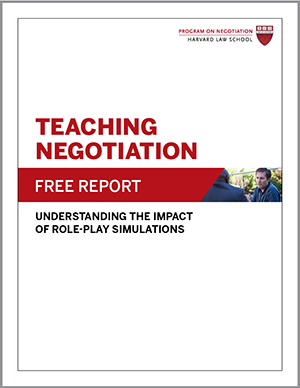
Amid our polarized political climate, dysfunction and conflict seem to rule the day in the U.S. Congress and state legislatures. To help legislators and their staff learn to build bridges and negotiate through impasse, the Harvard Kennedy School (HKS) Legislative Negotiation Project, with support from the William and Flora Hewlett Foundation Madison Initiative, has developed free law teaching materials on effective legislative negotiation. One of the Legislative Negotiation Project team members, Kessely Hong, faculty chair of the Master in Public Administration Programs and lecturer in Public Policy at HKS, explained to Negotiation Briefings how practicing key negotiation principles can help lawmakers reach their goals.
How law teaching materials are helping legislators work towards bipartisanship
NB: What inspired the Legislative Negotiation Project?
Kessely Hong: The Legislative Negotiation Project is the brainchild of HKS professor Jane Mansbridge. She observed the many recent examples of legislative gridlock and the challenges inherent in advancing sound public policy through the legislative negotiation process in a highly partisan environment. She built a team of faculty from the Kennedy School and greater Harvard community to interview current and former legislators, and study examples of political negotiation, with the goal of developing legislative law teaching materials to train legislators and staff at both the state and federal levels on negotiation strategies to achieve successful bipartisan agreements.
NB: How do you define “legislative negotiation,” and how does it differ from other types of negotiation?
KH: Legislative negotiation encompasses all the strategy work and interactions that lead up to the passage (or attempted passage) of new legislation. As with other types of negotiation, a legislative agreement requires buy-in from a group of parties who may have varying interests, priorities, and alternatives; however, legislative negotiation differs from typical business transactions in several ways. First, legislative negotiation takes place in a polarized partisan context, where negotiators care about not only reaching an agreement but also demonstrating loyalty to their side and winning reelection. Second, many aspects of legislative negotiation are very public—for example, C-SPAN broadcasts Congressional debate on TV, and the media covers negotiations by the hour. Third, in our era of “fake news,” it is easy for citizens, as well as legislators and staff, to become increasingly loyal to “their” side and very distrustful of the other side. Finally, legislative negotiation is a highly complex process with many players: Legislation begins in committees before being brought to a vote; the content must be negotiated across chambers; and the threat of an executive branch veto looms overhead.
NB: While they are charged with representing their constituents’ interests, legislators are also influenced by lobbyists, donors, the media, and other groups. Amid these competing voices and potentially corrupting influences, how can they keep their primary goal at the forefront?
KH: In his 1988 article “Diplomacy and Domestic Politics: The Logic of Two-Level Games” in the journal International Organization, the scholar Robert Putnam wrote about negotiation as a “two-level game.” That is, many negotiations that initially appear to be solely between representatives of different parties also require negotiations with various internal stakeholders whose support may be necessary for the deal to go through.
In legislative negotiation, multiple levels of negotiation can involve voters, party leaders, leaders from the other chambers, donors, lobbyists, the media, and more. This represents a complicated challenge, but it’s also an opportunity. Legislators and their staff know that, to earn a given legislator’s support, they will have to demonstrate how support for a bill will increase the legislator’s standing with his or her constituents. Take the 2014 Water for the World Act, which prioritizes sanitation and clean water worldwide. To get it through, the bill’s sponsors in the U.S. House partnered with lobbyists and faith-based groups to emphasize how it would improve security for marginalized communities; this helped win support from lawmakers who were originally concerned about the cost.
NB: How is this new project going so far?
KH: We have run several training sessions with legislators and senior staffers at both the state and federal levels, including at the Library of Congress. In follow-up surveys, participants have told us that the training sessions and law teaching materials helped them move away from a “zero-sum” (win-lose) mindset; equipped them to listen better, ask questions, and learn about other parties’ perspectives; understand that the “other side” may represent a variety of viewpoints and is not monolithic; recognize the need to give others a “win” to earn their buy-in; and reframe proposals in language that won’t feel toxic to the other side.
What materials have you found helpful in improving your negotiations in deeply divided situations?





